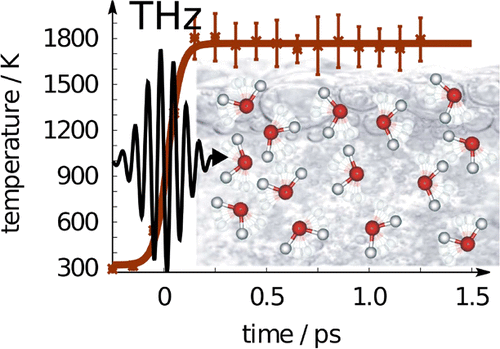当前位置:
X-MOL 学术
›
J. Phys. Chem. A
›
论文详情
Our official English website, www.x-mol.net, welcomes your
feedback! (Note: you will need to create a separate account there.)
Prospects of Using High-Intensity THz Pulses To Induce Ultrafast Temperature-Jumps in Liquid Water
The Journal of Physical Chemistry A ( IF 2.7 ) Pub Date : 2018-05-18 00:00:00 , DOI: 10.1021/acs.jpca.8b00828 Pankaj Kr. Mishra 1, 2 , Vincent Bettaque 3 , Oriol Vendrell 4 , Robin Santra 1, 2, 3 , Ralph Welsch 1
The Journal of Physical Chemistry A ( IF 2.7 ) Pub Date : 2018-05-18 00:00:00 , DOI: 10.1021/acs.jpca.8b00828 Pankaj Kr. Mishra 1, 2 , Vincent Bettaque 3 , Oriol Vendrell 4 , Robin Santra 1, 2, 3 , Ralph Welsch 1
Affiliation

|
Ultrashort, high-intensity terahertz (THz) pulses, e.g., generated at free-electron laser facilities, allow for direct investigation as well as the driving of intermolecular modes in liquids like water and thus will deepen our understanding of the hydrogen bonding network. In this work, the temperature-jump (T-jump) of water induced by THz radiation is simulated for ten different THz frequencies in the range from 3 to 30 THz and five different pulse intensities in the range from 1 × 1011 to 5 × 1012 W/cm2 employing both ab initio molecular dynamics (AIMD) and force field molecular dynamics (FFMD) approaches. The most efficient T-jump can be achieved with 16 THz pulses. Three distinct T-jump mechanisms can be uncovered. For all cases, the T-jump mechanism proceeds within tens of femtoseconds (fs). For frequencies between 10 and 25 THz, most of the energy is initially transferred to the rotational degrees of freedom. Subsequently, the energy is redistributed to the translational and intramolecular vibrational degrees of freedom within a maximum of 500 fs. For the lowest frequencies considered (7 THz and below), translational and rotational degrees of freedom are heated within tens of fs as the THz pulse also couples to the intermolecular vibrations. Subsequently, the intramolecular vibrational modes are heated within a few hundred fs. At the highest frequencies considered (25 THz and above), vibrational and rotational degrees of freedom are heated within tens of fs, and energy redistribution to the translational degrees of freedom happens within several hundred fs. Both AIMD and FFMD simulations show a similar dependence of the T-jump on the frequency employed. However, the FFMD simulations overestimate the total energy transfer around the main peak and drop off too fast toward frequencies higher and lower than the main peak. These differences can be rationalized by missing elements, such as the polarizability, in the TIP4P/2005f force field employed. The feasibility of performing experiments at the studied frequencies and intensities as well as important issues such as energy efficiency, penetration depth, and focusing are discussed.
中文翻译:

利用高强度太赫兹脉冲在液态水中引起超快温度跃变的前景
超短,高强度太赫兹(THz)脉冲,例如在自由电子激光设备上产生的脉冲,可用于直接研究以及驱动像水这样的液体中的分子间模式,因此将加深我们对氢键网络的理解。在这项工作中,针对3种至30 THz范围内的10种不同的THz频率和1×10 11至5×范围内的5种不同的脉冲强度,模拟了由THz辐射引起的水的温度跃变(T-jump)。使用从头开始的10 12 W / cm 2分子动力学(AIMD)和力场分子动力学(FFMD)方法。16个THz脉冲可以实现最有效的T跳。可以发现三种不同的T跳机制。对于所有情况,T跳机制都在数十飞秒(fs)内进行。对于10到25 THz之间的频率,大部分能量最初都传递给旋转自由度。随后,能量在最大500 fs内重新分配给平移和分子内振动自由度。对于考虑的最低频率(7 THz及以下),由于THz脉冲还会耦合到分子间振动,因此平移和旋转自由度会在数十fs内加热。随后,分子内振动模式在数百fs内加热。在考虑的最高频率(25 THz及以上)下,振动和旋转自由度在数十fs之内加热,并且能量向平移自由度的重新分配在数百fs之内发生。AIMD和FFMD仿真都显示了T跳对所采用频率的相似依赖性。但是,FFMD模拟高估了主峰周围的总能量传输,并且在高于和低于主峰的频率处下降太快。这些差异可以通过在TIP4P / 2005f力场中缺少诸如极化率之类的元素来合理化。讨论了在所研究的频率和强度下进行实验的可行性以及能量效率,穿透深度和聚焦等重要问题。振动和旋转自由度在数十fs之内被加热,能量向平移自由度的重新分布发生在几百fs之内。AIMD和FFMD仿真都显示了T跳对所采用频率的相似依赖性。但是,FFMD模拟高估了主峰周围的总能量传输,并且在高于和低于主峰的频率处下降太快。这些差异可以通过在TIP4P / 2005f力场中缺少诸如极化率之类的元素来合理化。讨论了在所研究的频率和强度下进行实验的可行性以及诸如能量效率,穿透深度和聚焦等重要问题。振动和旋转自由度在数十fs之内被加热,能量向平移自由度的重新分布发生在几百fs之内。AIMD和FFMD仿真都显示出T跳对所采用频率的相似依赖性。但是,FFMD仿真高估了主峰周围的总能量传递,并且在高于和低于主峰的频率处下降太快。这些差异可以通过在TIP4P / 2005f力场中缺少诸如极化率之类的元素来合理化。讨论了在所研究的频率和强度下进行实验的可行性以及诸如能量效率,穿透深度和聚焦等重要问题。能量向平移自由度的重新分配发生在数百fs之内。AIMD和FFMD仿真都显示了T跳对所采用频率的相似依赖性。但是,FFMD模拟高估了主峰周围的总能量传输,并且在高于和低于主峰的频率处下降太快。这些差异可以通过在TIP4P / 2005f力场中缺少诸如极化率之类的元素来合理化。讨论了在所研究的频率和强度下进行实验的可行性以及诸如能量效率,穿透深度和聚焦等重要问题。能量向平移自由度的重新分配发生在数百fs之内。AIMD和FFMD仿真都显示了T跳对所采用频率的相似依赖性。但是,FFMD模拟高估了主峰周围的总能量传输,并且在高于和低于主峰的频率处下降太快。这些差异可以通过在TIP4P / 2005f力场中缺少诸如极化率之类的元素来合理化。讨论了在所研究的频率和强度下进行实验的可行性以及诸如能量效率,穿透深度和聚焦等重要问题。FFMD仿真高估了主峰周围的总能量传递,并且在高于和低于主峰的频率处下降太快。这些差异可以通过在TIP4P / 2005f力场中缺少诸如极化率之类的元素来合理化。讨论了在所研究的频率和强度下进行实验的可行性以及诸如能量效率,穿透深度和聚焦等重要问题。FFMD仿真高估了主峰周围的总能量传递,并且在高于和低于主峰的频率处下降太快。这些差异可以通过在TIP4P / 2005f力场中缺少诸如极化率之类的元素来合理化。讨论了在所研究的频率和强度下进行实验的可行性以及诸如能量效率,穿透深度和聚焦等重要问题。
更新日期:2018-05-18
中文翻译:

利用高强度太赫兹脉冲在液态水中引起超快温度跃变的前景
超短,高强度太赫兹(THz)脉冲,例如在自由电子激光设备上产生的脉冲,可用于直接研究以及驱动像水这样的液体中的分子间模式,因此将加深我们对氢键网络的理解。在这项工作中,针对3种至30 THz范围内的10种不同的THz频率和1×10 11至5×范围内的5种不同的脉冲强度,模拟了由THz辐射引起的水的温度跃变(T-jump)。使用从头开始的10 12 W / cm 2分子动力学(AIMD)和力场分子动力学(FFMD)方法。16个THz脉冲可以实现最有效的T跳。可以发现三种不同的T跳机制。对于所有情况,T跳机制都在数十飞秒(fs)内进行。对于10到25 THz之间的频率,大部分能量最初都传递给旋转自由度。随后,能量在最大500 fs内重新分配给平移和分子内振动自由度。对于考虑的最低频率(7 THz及以下),由于THz脉冲还会耦合到分子间振动,因此平移和旋转自由度会在数十fs内加热。随后,分子内振动模式在数百fs内加热。在考虑的最高频率(25 THz及以上)下,振动和旋转自由度在数十fs之内加热,并且能量向平移自由度的重新分配在数百fs之内发生。AIMD和FFMD仿真都显示了T跳对所采用频率的相似依赖性。但是,FFMD模拟高估了主峰周围的总能量传输,并且在高于和低于主峰的频率处下降太快。这些差异可以通过在TIP4P / 2005f力场中缺少诸如极化率之类的元素来合理化。讨论了在所研究的频率和强度下进行实验的可行性以及能量效率,穿透深度和聚焦等重要问题。振动和旋转自由度在数十fs之内被加热,能量向平移自由度的重新分布发生在几百fs之内。AIMD和FFMD仿真都显示了T跳对所采用频率的相似依赖性。但是,FFMD模拟高估了主峰周围的总能量传输,并且在高于和低于主峰的频率处下降太快。这些差异可以通过在TIP4P / 2005f力场中缺少诸如极化率之类的元素来合理化。讨论了在所研究的频率和强度下进行实验的可行性以及诸如能量效率,穿透深度和聚焦等重要问题。振动和旋转自由度在数十fs之内被加热,能量向平移自由度的重新分布发生在几百fs之内。AIMD和FFMD仿真都显示出T跳对所采用频率的相似依赖性。但是,FFMD仿真高估了主峰周围的总能量传递,并且在高于和低于主峰的频率处下降太快。这些差异可以通过在TIP4P / 2005f力场中缺少诸如极化率之类的元素来合理化。讨论了在所研究的频率和强度下进行实验的可行性以及诸如能量效率,穿透深度和聚焦等重要问题。能量向平移自由度的重新分配发生在数百fs之内。AIMD和FFMD仿真都显示了T跳对所采用频率的相似依赖性。但是,FFMD模拟高估了主峰周围的总能量传输,并且在高于和低于主峰的频率处下降太快。这些差异可以通过在TIP4P / 2005f力场中缺少诸如极化率之类的元素来合理化。讨论了在所研究的频率和强度下进行实验的可行性以及诸如能量效率,穿透深度和聚焦等重要问题。能量向平移自由度的重新分配发生在数百fs之内。AIMD和FFMD仿真都显示了T跳对所采用频率的相似依赖性。但是,FFMD模拟高估了主峰周围的总能量传输,并且在高于和低于主峰的频率处下降太快。这些差异可以通过在TIP4P / 2005f力场中缺少诸如极化率之类的元素来合理化。讨论了在所研究的频率和强度下进行实验的可行性以及诸如能量效率,穿透深度和聚焦等重要问题。FFMD仿真高估了主峰周围的总能量传递,并且在高于和低于主峰的频率处下降太快。这些差异可以通过在TIP4P / 2005f力场中缺少诸如极化率之类的元素来合理化。讨论了在所研究的频率和强度下进行实验的可行性以及诸如能量效率,穿透深度和聚焦等重要问题。FFMD仿真高估了主峰周围的总能量传递,并且在高于和低于主峰的频率处下降太快。这些差异可以通过在TIP4P / 2005f力场中缺少诸如极化率之类的元素来合理化。讨论了在所研究的频率和强度下进行实验的可行性以及诸如能量效率,穿透深度和聚焦等重要问题。











































 京公网安备 11010802027423号
京公网安备 11010802027423号